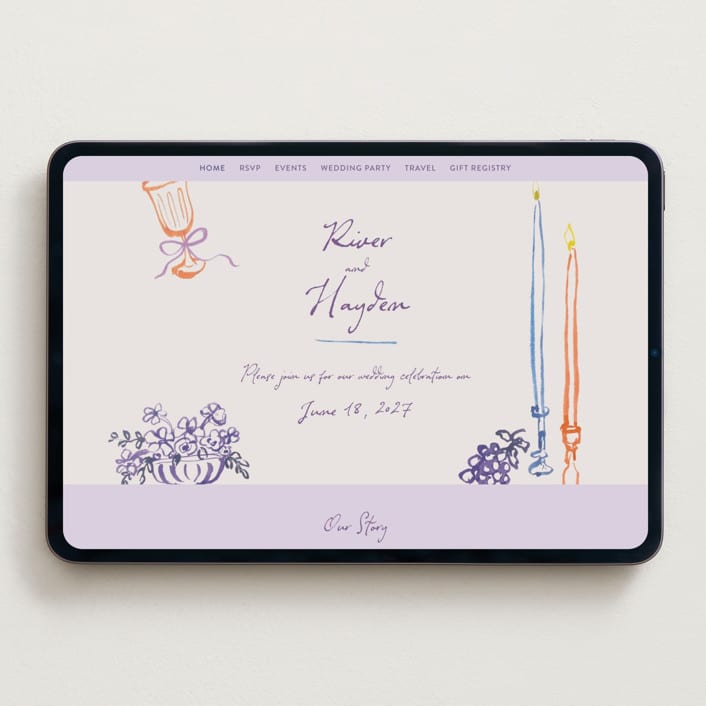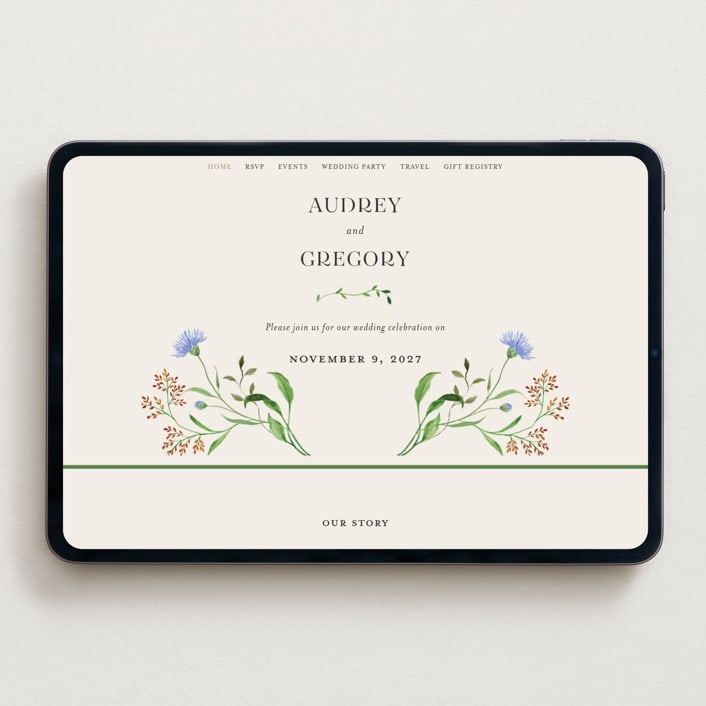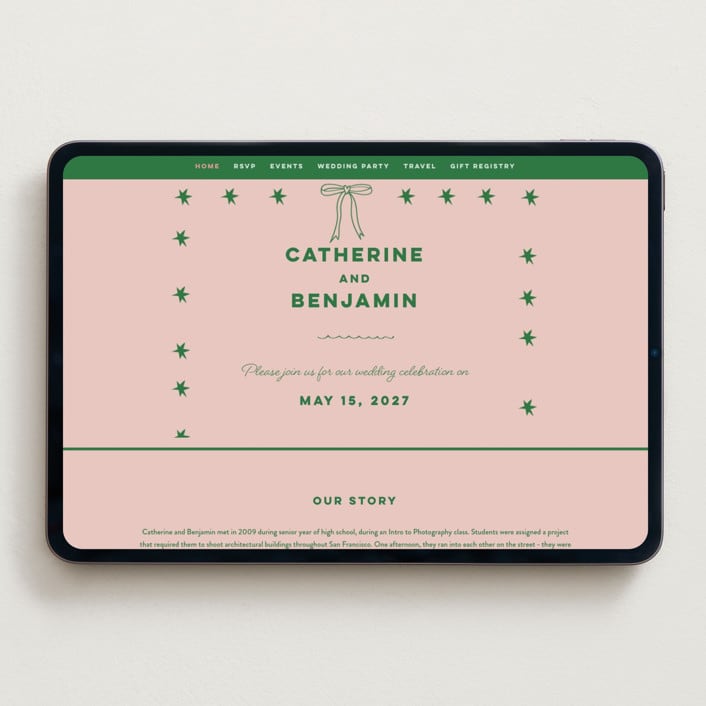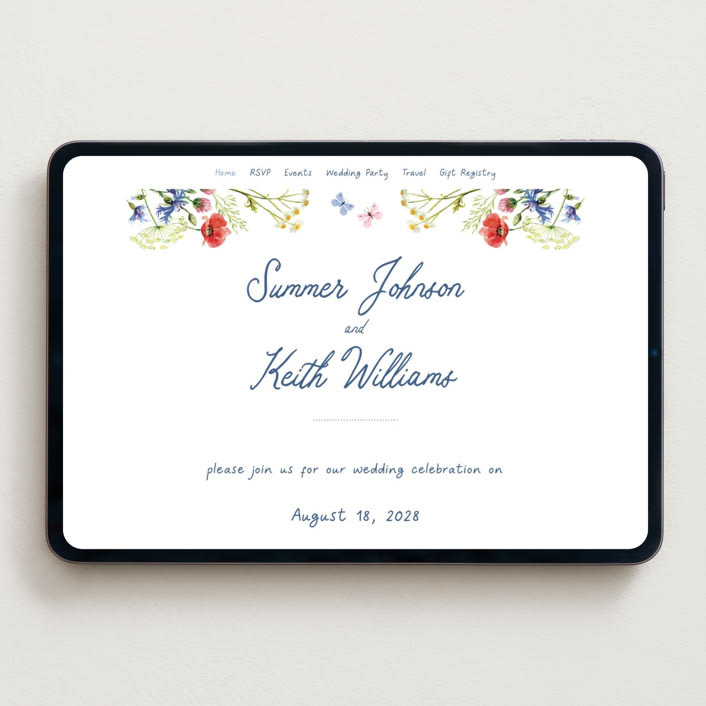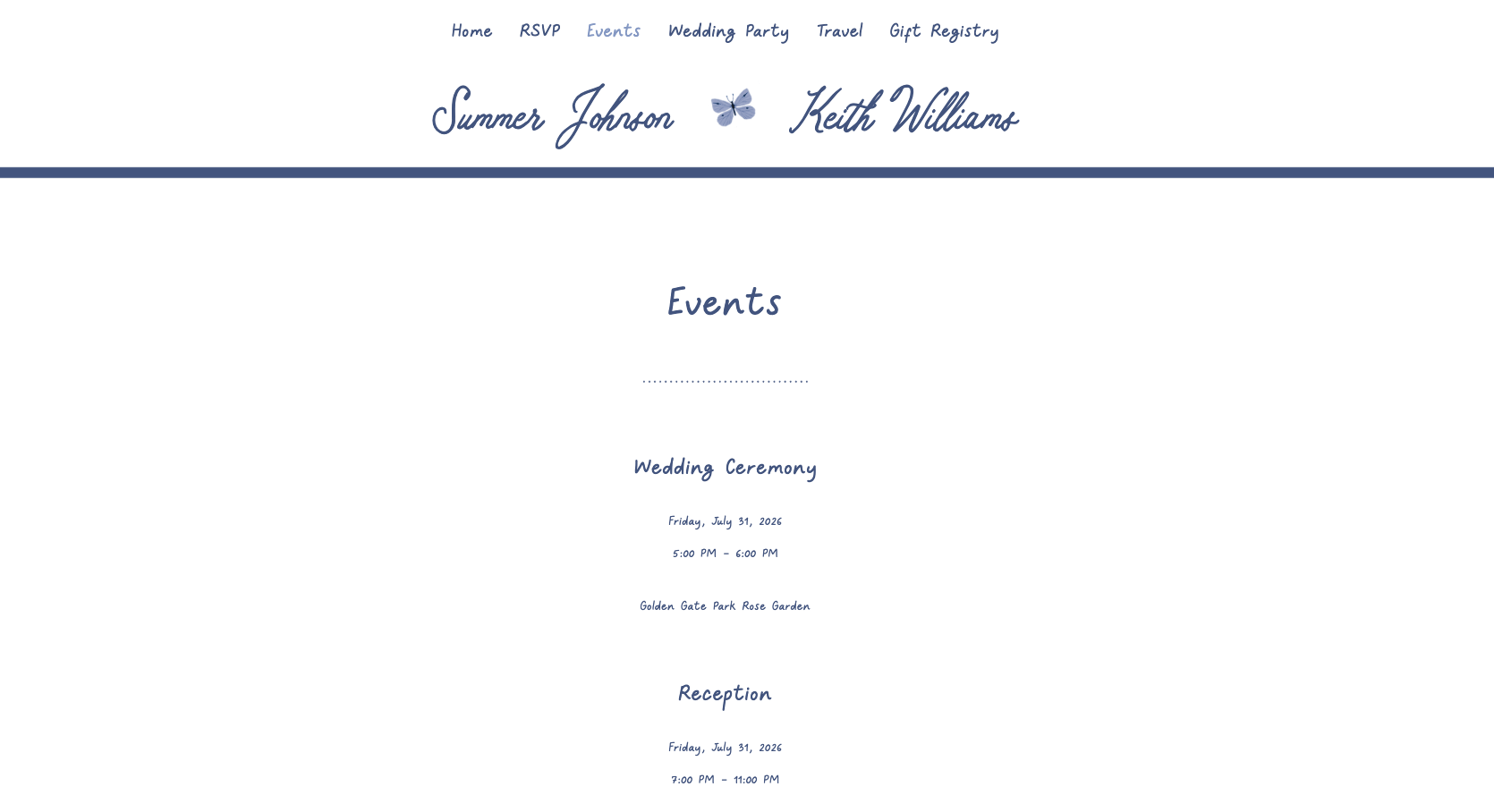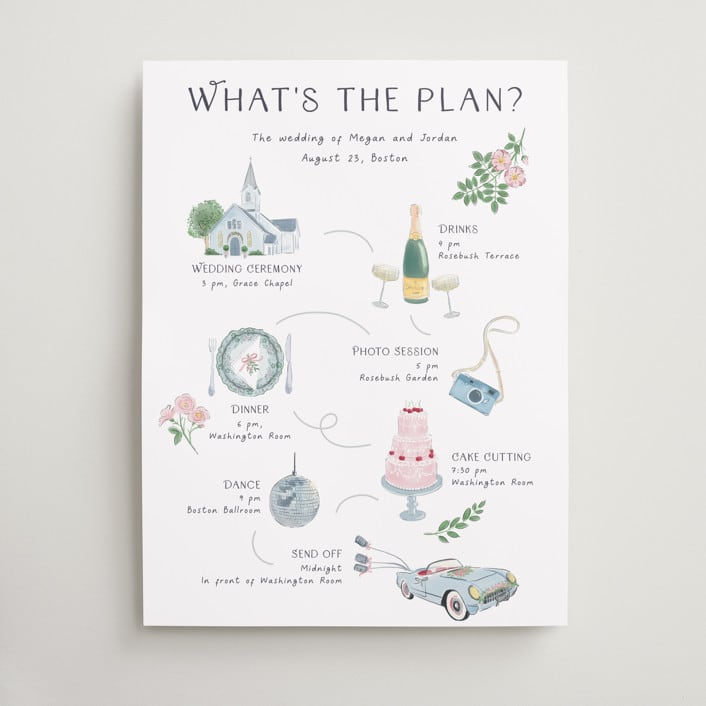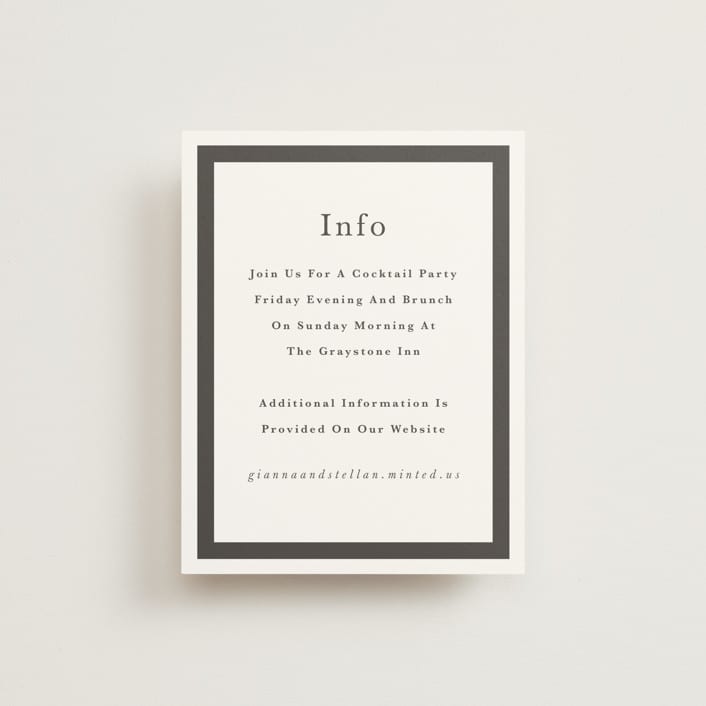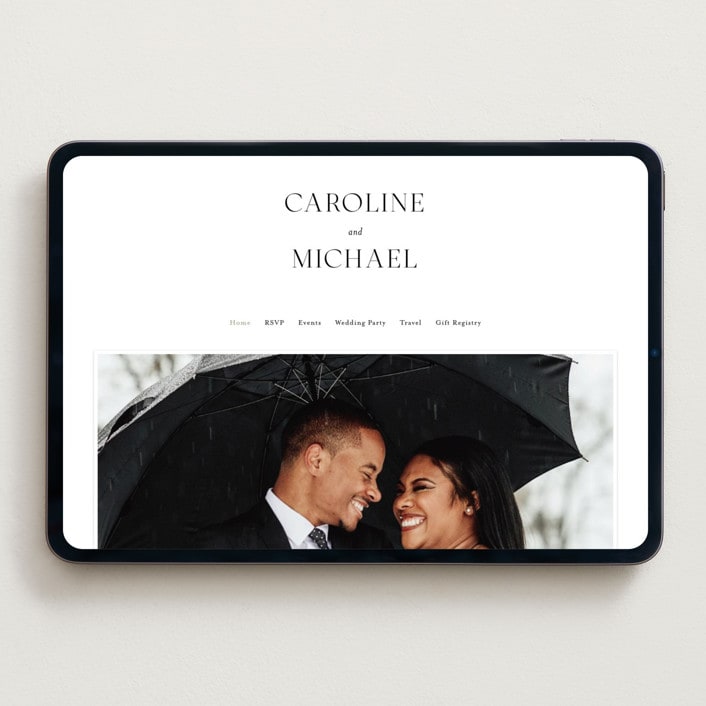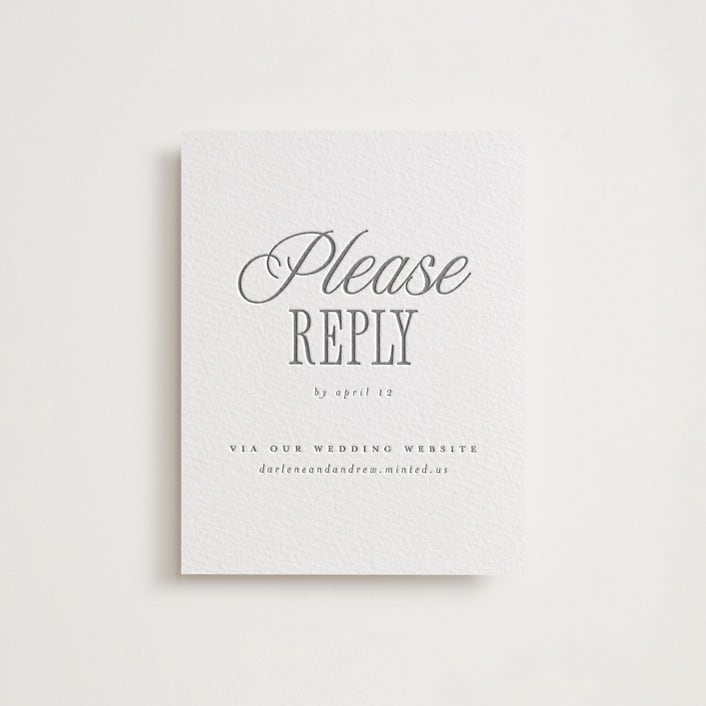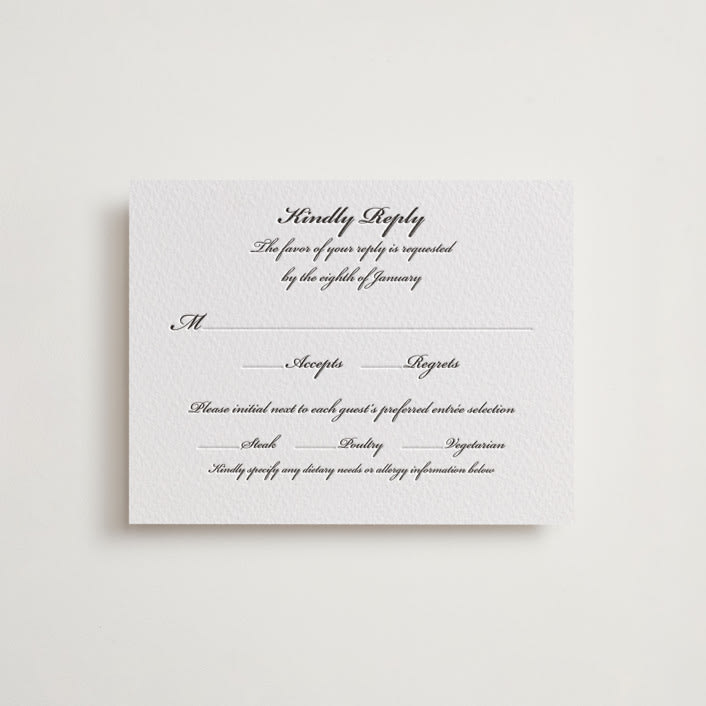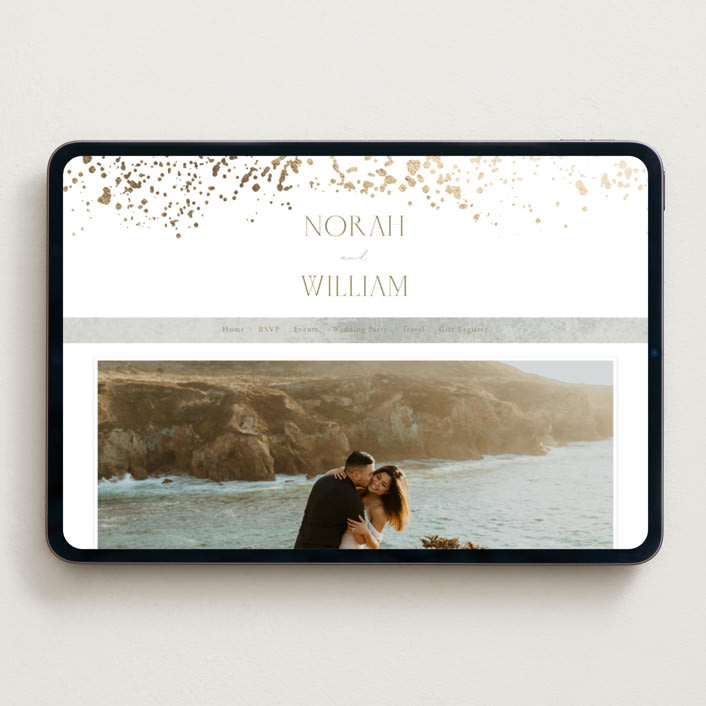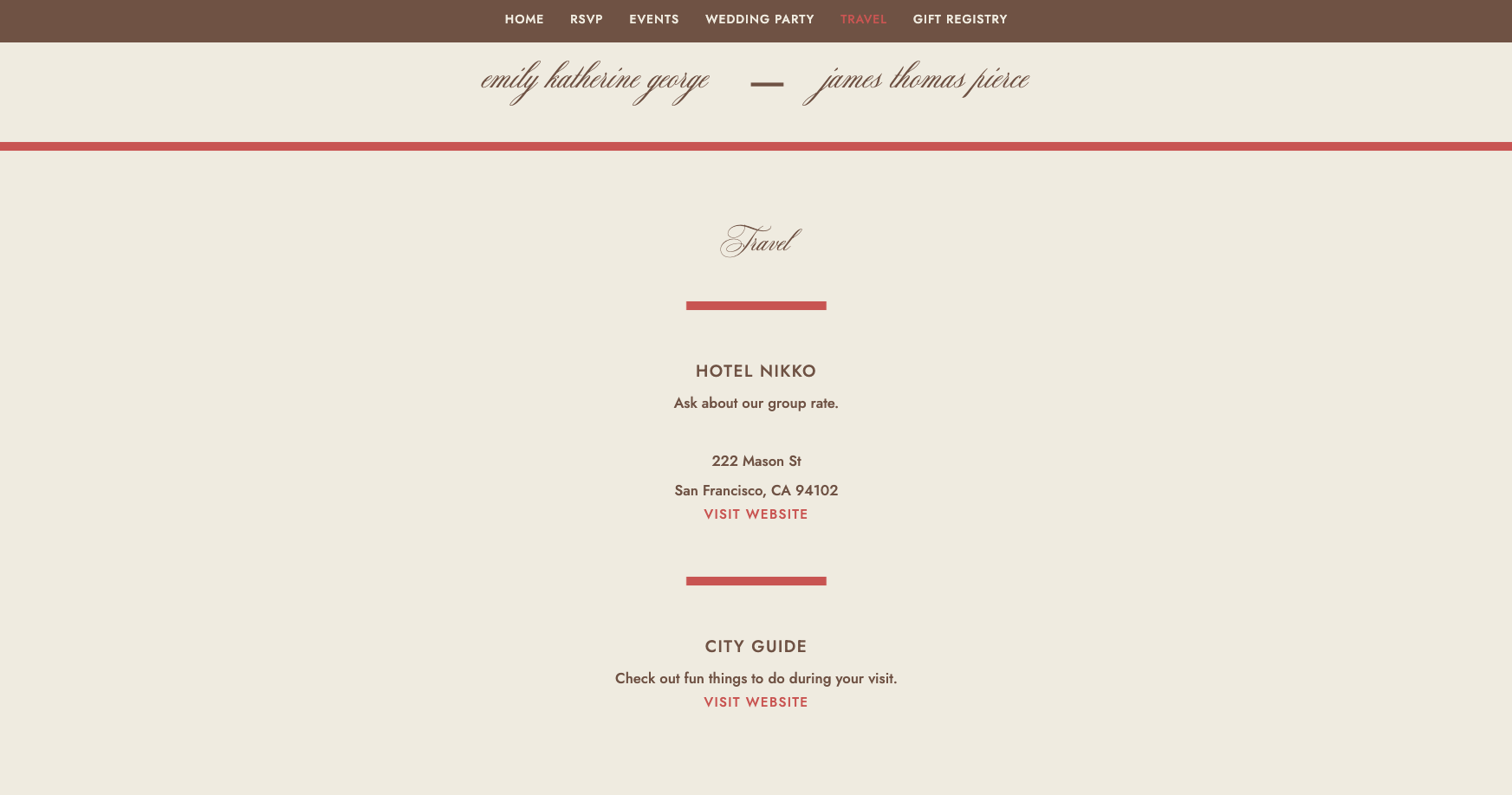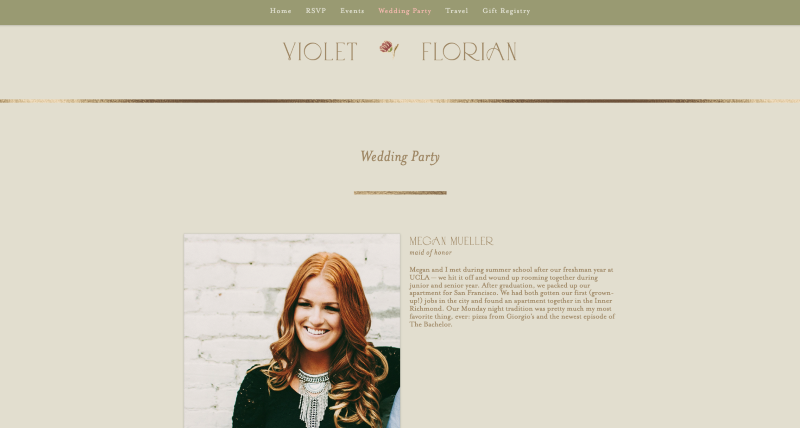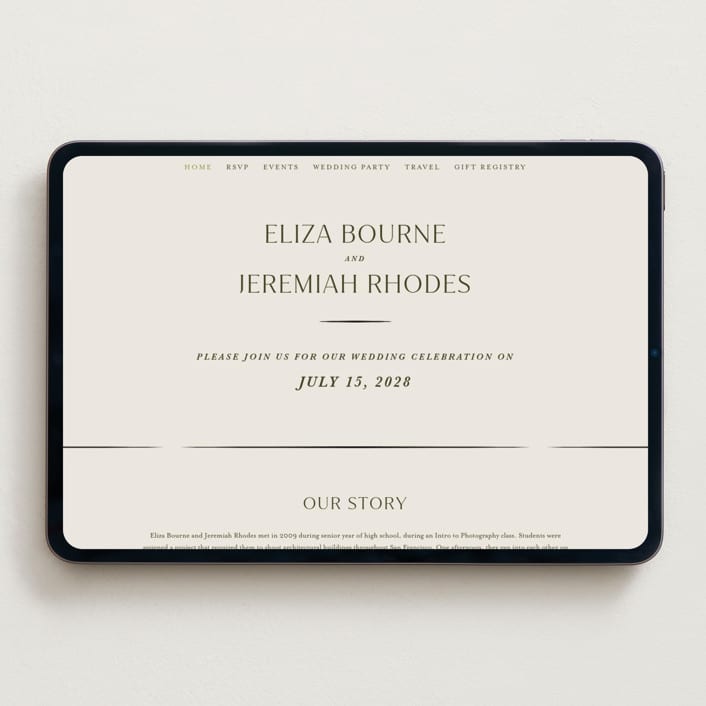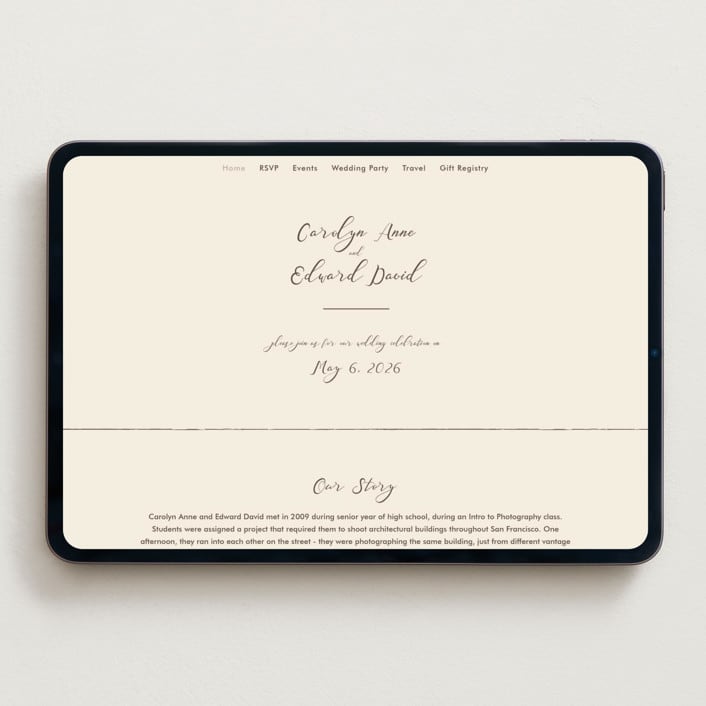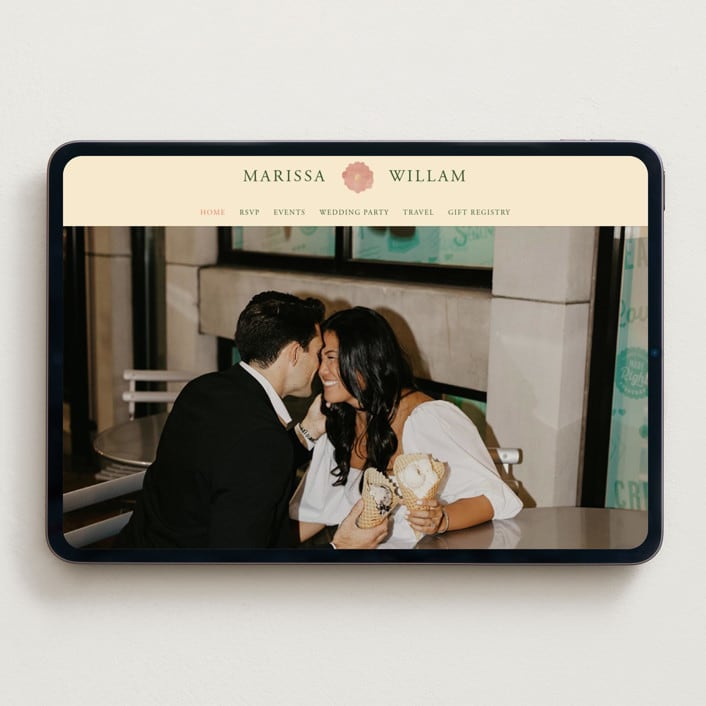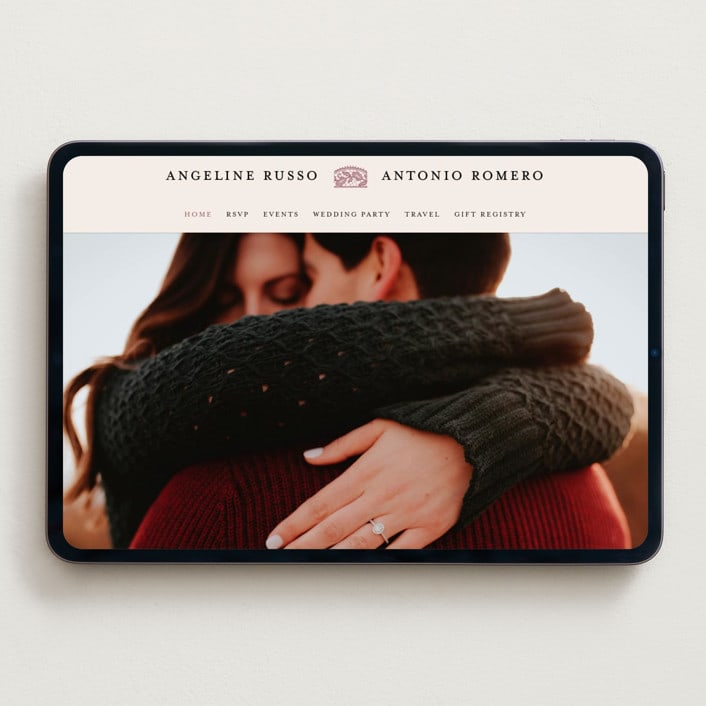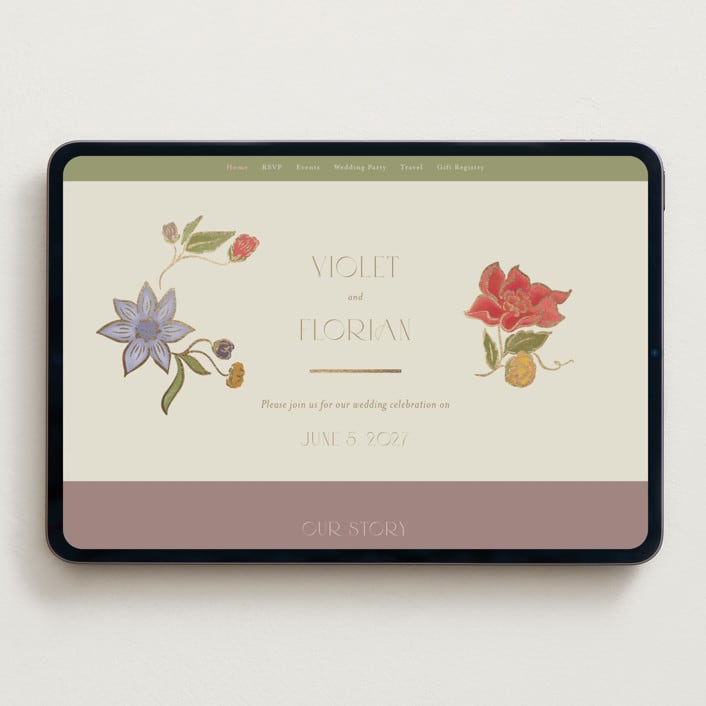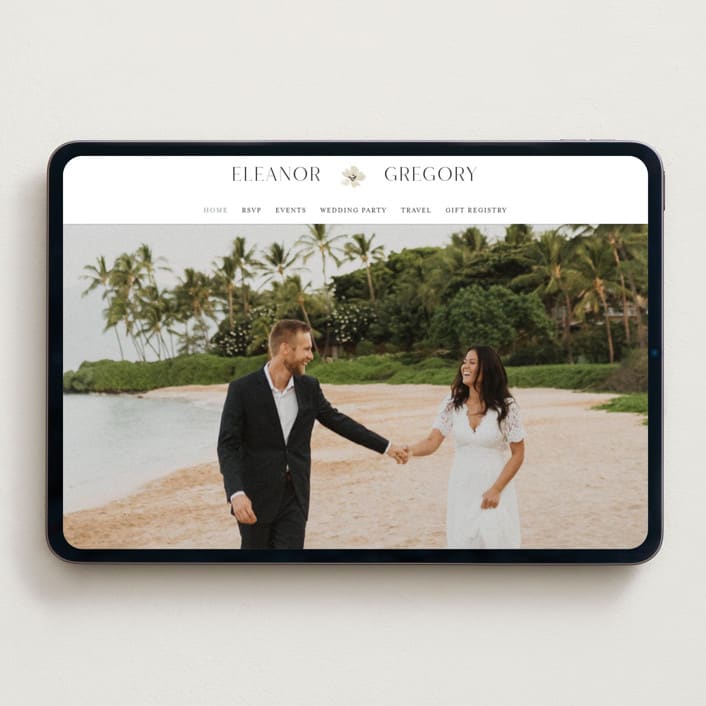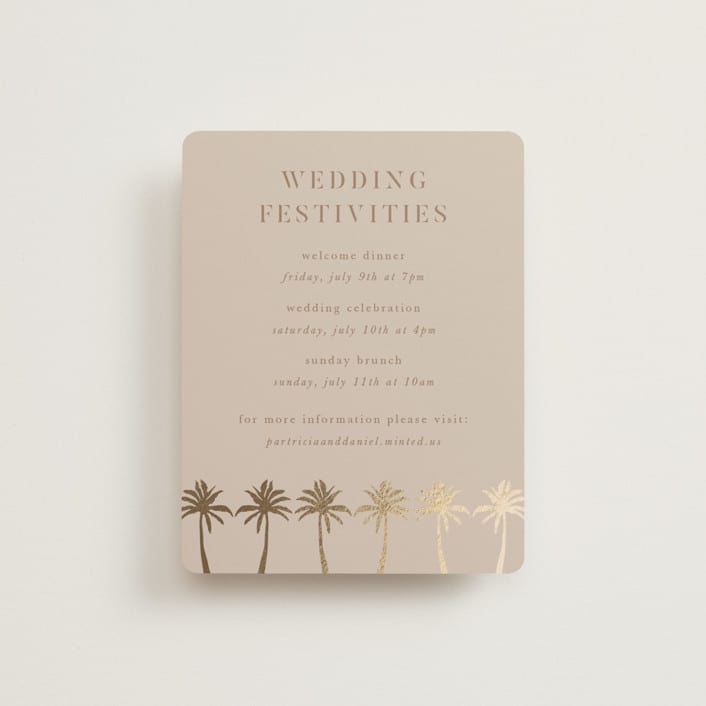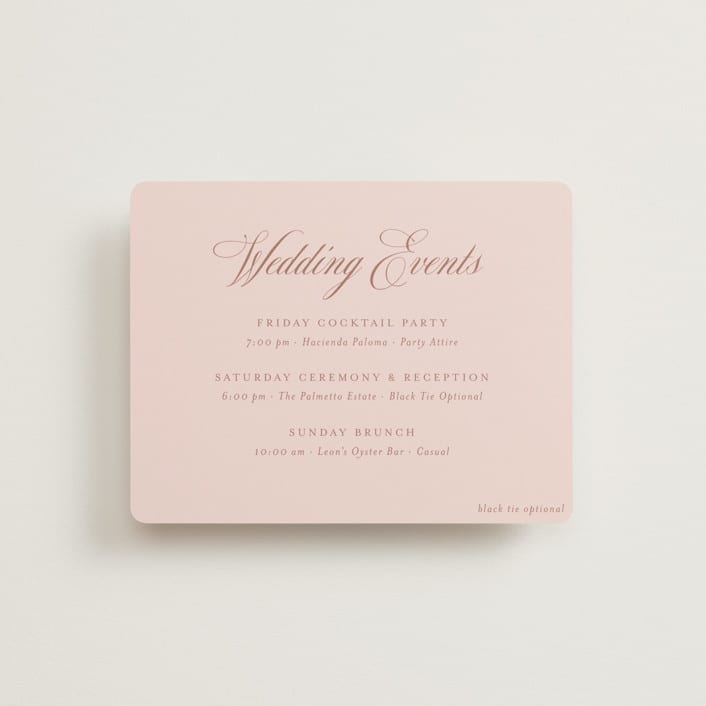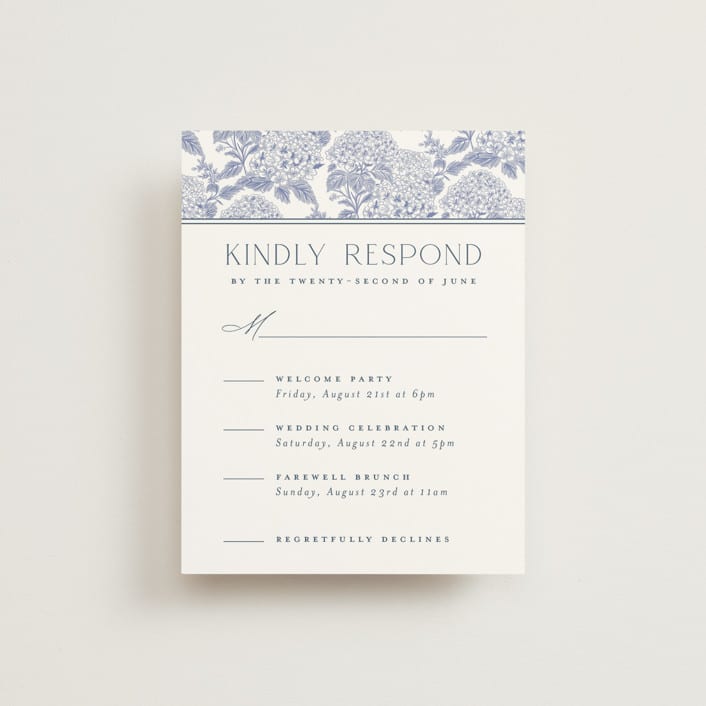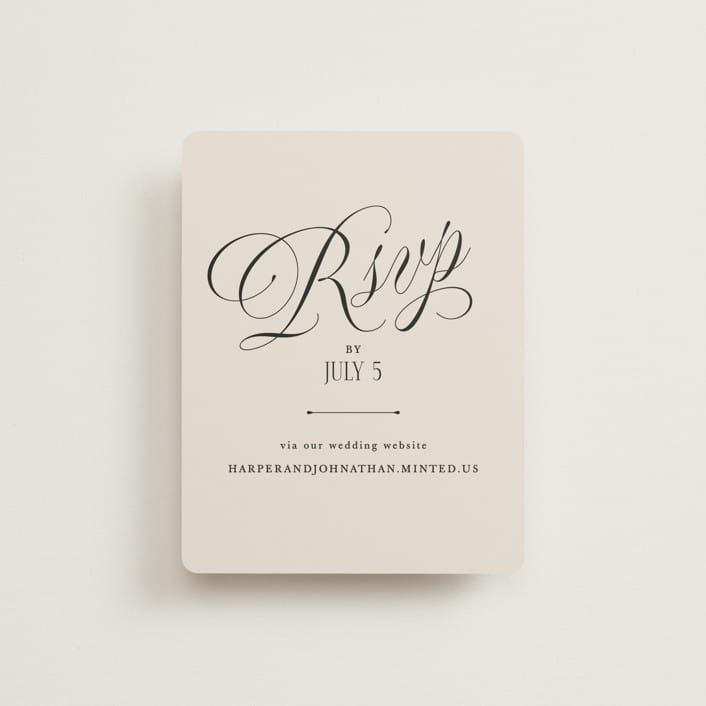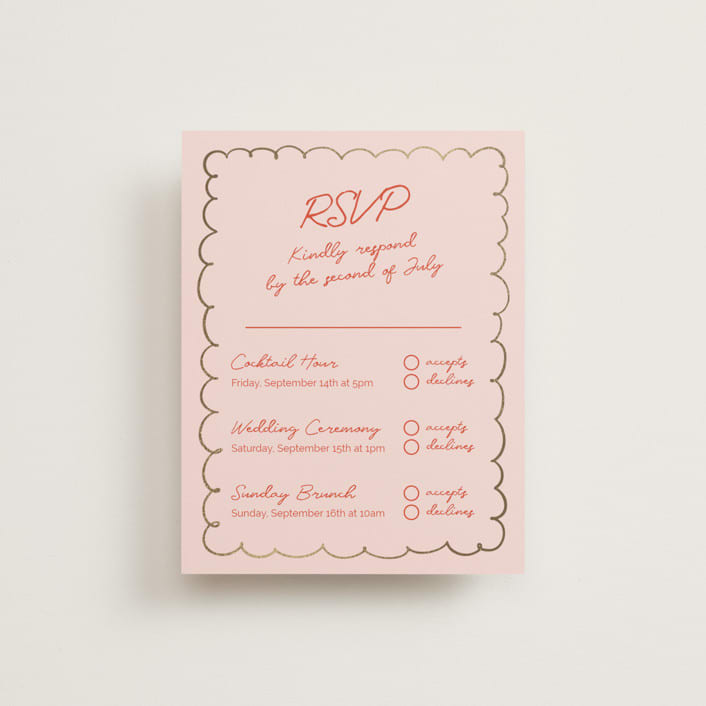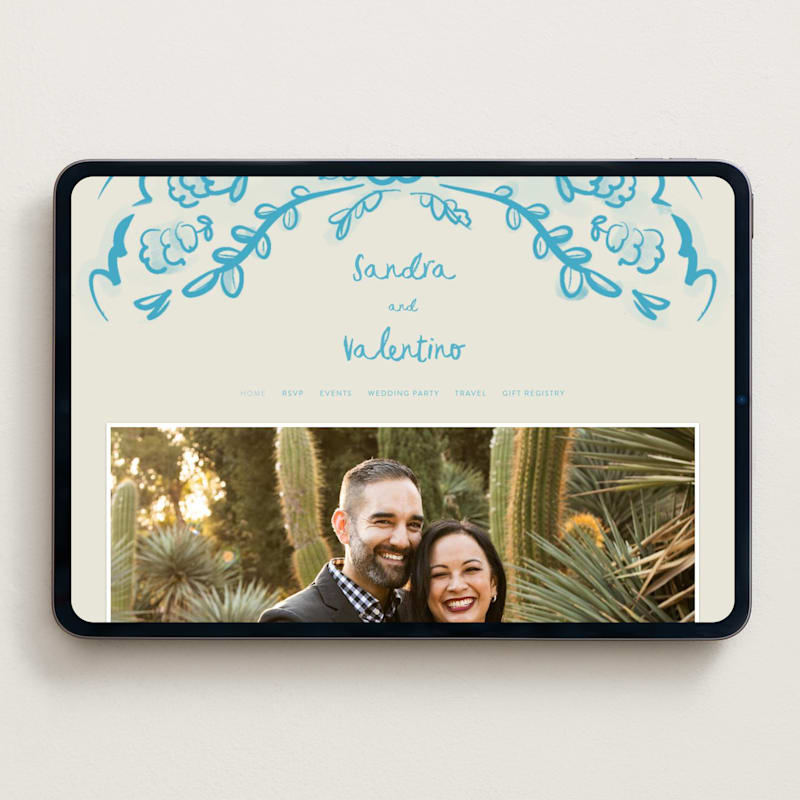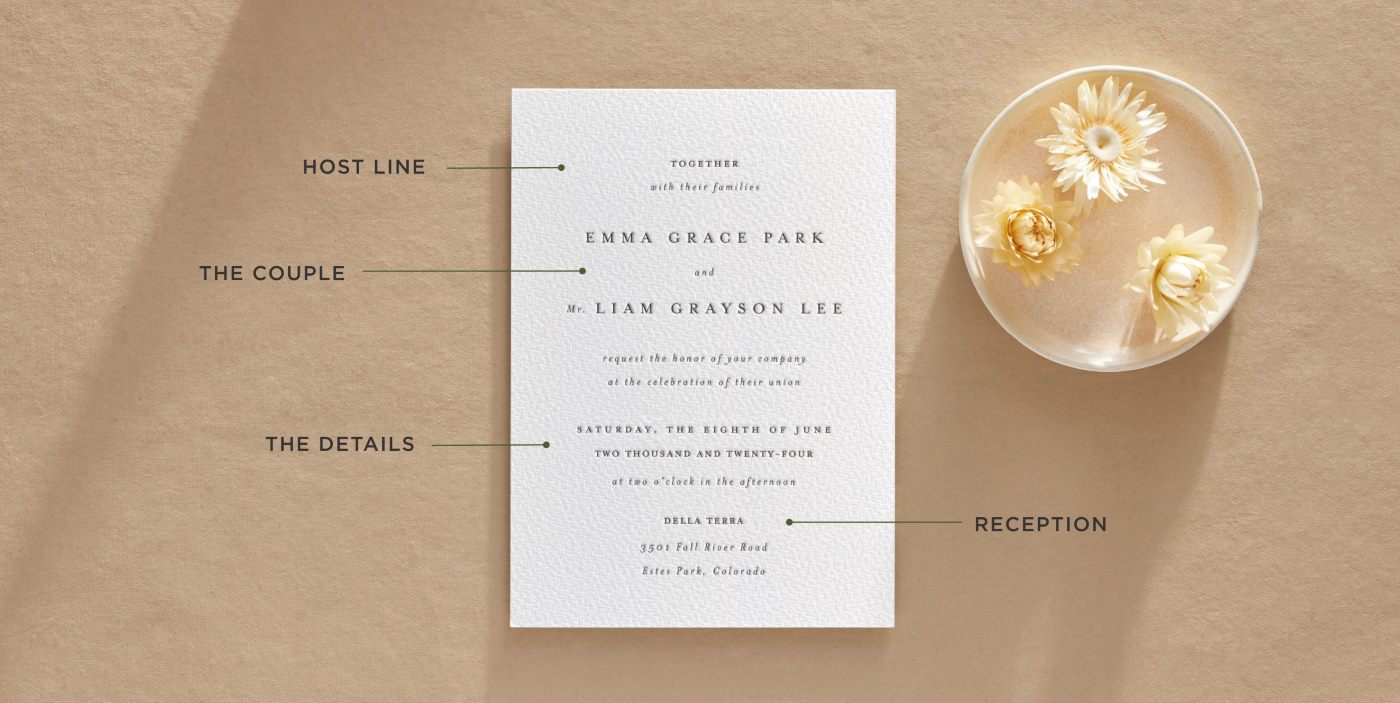Key Takeaways:
- Crafting personalized and engaging wedding website wording helps set the tone for your celebration and makes guests feel connected to your love story.
- Including clear, guest-friendly details like RSVP instructions, event schedules, and travel information ensures a seamless experience for attendees.
- Adding personal touches, such as your love story, wedding party bios, and creative special requests, transforms your website into a meaningful extension of your celebration.
Your wedding website is often the first stop on your guests’ journey to your big day. It’s where they’ll find the when and where. The right language can make your site feel personal and set the tone before anyone steps into the venue. It can even spark genuine excitement about everything from your playlist to your menu.
In the article ahead, you’ll find 30 examples that blend personality with practicality. Designed to help you create a wedding website that informs, delights, and makes your guests feel right at home!
If you’re looking for inspiration beyond wording, Minted has that too! You can create your wedding website for free with Minted, and choose from hundreds of beautifully designed templates to match your style from the very first click.
What components should your wedding website have?
Think of your wedding website as the manual to your wedding. It will give your guests everything they need to show up prepared and excited. The best wedding website components mix must-have info with personal touches that show off your story as a couple as well. Here are a few components most couples choose to keep:
- Event Details & RSVP - Includes ceremony and reception times, locations, directions, and a simple RSVP system that makes it easy for loved ones to confirm their presence
- Our Story & About Us - A short page where you can share your love story with an engaging tale that helps friends and family feel more connected to your celebration
- Wedding Party Introductions - A page to introduce your VIPs with fun facts, photos, and short bios so everyone can put faces to names before the big day
- Travel & Accommodations - Provide hotel recommendations, booking codes, and local tips to help out-of-town loved ones plan their visit
- FAQ Section - Address common questions about dress codes, dietary restrictions, and venue logistics to save everyone from those "wait, what time?" texts
- Guest Information & Policies - Clearly communicate important info like plus-one policies, kids' guidelines, and any special requests in a warm, welcoming tone
Welcome & about us: Setting the scene
Your Welcome and About Us sections create that important first impression that draws people into your story as a couple and gets them excited for your big day. These opening moments on your site should feel like you're greeting loved ones at your front door—warm, genuine, and excited to share what's coming next.
Many couples also find that including their love story in the About Us section adds a personal touch that people genuinely appreciate. The key is sharing moments that feel meaningful without overwhelming visitors with every detail. A quick story about how you met, what you love doing together, or why you chose your wedding date helps everyone connect with your celebration on a deeper level.
Here are some quick examples of what the wording in these sections can look like!
1.Warm and playful welcome messages
If you like the idea of keeping things light and friendly, try a warm and playful welcome. It’s an easy way to make guests feel comfortable and let them know your wedding will be fun.
Add something personal so it feels like you. That could be a little joke about how you met, a phrase you say to each other all the time, or a nod to something you both love. Even one small detail makes it feel real instead of generic.
Examples:
- We’re getting married! Can’t wait to celebrate with our favorite people. Thanks for being part of our story.
- We’ve got the date, the place, and the dance floor ready… all we need is YOU.
- We’re so happy you’re here. Take a look around, find all the details, and get ready for a day full of love (and bad dance moves!)
Keep it short—three sentences or less—so people can catch the vibe quickly and then head straight to the rest of your site.
2.Classic welcome wording with a twist
If you like the elegance of a traditional wedding welcome but don’t want it to feel stiff, you can keep the classic format and just add a few personal touches. You can keep the timeless opening line and then work in a small detail about you as a couple. Instead of “We cordially invite you to celebrate our union,” try “We cordially invite you to celebrate our union… and dance to plenty of 80s music.” Little extras like that let guests know it’s going to be warm and welcoming, not overly serious.
Examples:
- We are delighted to share this special day with our family and friends. Join us as we exchange vows and toast to a lifetime of happiness together.
- It is with great joy that we invite you to witness our wedding day. We’d love for you to be there when we say “I do” and stay all the way till we cut the cake!
- We’re overjoyed to announce our union, and would love to share this special day with you. We’re looking forward to a day of vows, food, and great company!
3.Quirky and fun welcome ideas
If you’d rather skip the formalities, a lighthearted welcome can set the tone right away. Humor works because it helps guests relax and shows them this is going to be a celebration, not a ceremony they have to tiptoe through.
Think about the moments that sum up your relationship—the running joke you’ve had for years, the way you can’t get through a road trip without three snack stops, or your shared love of a certain terrible dance move. Those are the kinds of details that make your welcome feel personal and memorable.
Examples:
- Did you not get the memo? We’re getting married! And you’re getting a night full of booze, cake, and dancing.
- This just got serious.
(Name) & (Name), (Date)
Better gear up now, we have a night full of booze, cake, and dancing waiting for you.
4.'Our story' wording for romantics
If you want your guests to feel connected to your day, sharing your story is a great place to start. A romantic version works best when it’s heartfelt but not over the top—think real moments that mattered to you, told in your own words.
Focus on the little details that made you fall for each other. It could be the first conversation you didn’t want to end, the moment you realised you wanted to introduce them to your family, or the proposal story that still makes you smile.
Here are some creative ideas to put your story out there:
Use a Q&A Format:When did you first realise your love for the other person?
Allison: I love wearing heels, but I can’t stand them for more than 5 minutes. On one of our dates, I took off my heels mid-dinner. John, seeing this, simply got up and left the table! I was so confused until he returned 5 minutes later with a pair of sneakers in my size. Apparently, he always kept them in case I ever needed them, and that’s just how I knew we were meant to be!
John: Honestly, just seeing the way Bruno (my lab) warmed up to her made me realize she was going to be beyond special to me.
Make a literal fairytale out of it, complete with 3rd person narration and everything:Once upon a time, in a city where good coffee and great tacos were equally treasured, Allison and John’s paths crossed. She was running late (as usual) and he was debating whether to order one taco or three. Their first conversation lasted longer than either expected, filled with laughter and a shared love for weekend road trips. Over time, they became each other’s favorite travel companion, taste-tester, and sounding board. And now, they’re starting their biggest adventure yet—married life.
5.Lighthearted 'our story' examples
While romantic storytelling works beautifully for some couples, others prefer to keep things light and laugh-worthy with perfectly imperfect moments that show guests the real you. The best lighthearted stories focus on those moments that didn't go according to plan but somehow brought you closer together.
Here are some unique ideas to put your story out there:
Try narrating both your points of view for the different moments you shared together:Allison: I first met John at a mutual friend’s party. He spilled his drink on me in the first 5 minutes of being introduced. Never thought I would see him again!
John: When I first met Allison at a friend’s party, I was so nervous to talk to her that I spilled my drink all over her! I’m surprised (and lucky) she gave me another chance!
Add a series of beloved pictures of the two of you and explain the day that those were captured:[Image of bride eating an ice cream cone]
That’s the day I realised that I’ll always need to get Allison 2 ice cream cones - because she ate mine!
If you don’t have images, you can also share short anecdotes or fun facts about each other:Fun fact: John thought I loved olives, so he always picked them out and gave them to me. But I actually hate them! The only reason I always took them from him was to make him happy!
Event details & RSVP: The need-to-know info
This is the part of your site where guests come for answers, so making it easy for them is key! Your event details should cover the basics: who, what, when, and where. When the information
Your RSVP section works the same way—simple, direct, and warm. Include the deadline, how to respond, and any extra info you need from guests, like meal preferences. A line or two in your own voice keeps it from sounding like a form letter.
Adding small touches, like parking tips, accessibility notes, or a quick timeline, shows guests you’ve thought about their whole experience, not just the ceremony. Done well, this section makes it easier for everyone to plan ahead and enjoy the day!
6.Event details made simple
This section is typically pretty straightforward, and we recommend keeping it this way to avoid any confusion down the road. Break down your celebration into the classic who, what, when, and where format to help guests quickly find what they need. Start with the ceremony details, then move to reception info, keeping each section distinct and easy to scan.
Once the essentials are covered, you can add a small personal touch—just a line about why you chose your date or location. Something like, “We fell in love with this garden because it’s where Jake proposed,” or “We picked October 15th because it’s the anniversary of our first date,” keeps it personal without making it long.
Example:
The Ceremony will be held on Saturday, June 10, at 4:00 PM
Venue: At Willow Creek Vineyard, 456 Vineyard Lane.
We chose this spot because it’s where we had our first wine tasting together three years ago.
7.Creative wording for the schedule of events
Your schedule of events is basically the day’s roadmap, but it doesn’t have to read like one. A few small tweaks can turn a list of times into something guests actually enjoy reading—and get excited about.
A well-structured program typically includes the couple's names, the order of events, and after-party details to guide guests through the day's festivities, but adding your personal flair makes it memorable.
Here are a few examples that combine practicality with different aesthetics:
Simple and clear:4:00 PM – Ceremony at Riverside Gardens
6:00 PM – Dinner and dancing at the vineyard barn
10:00 PM – Late-night snacks before we wrap up
4:00 PM – “I do” time in the garden
6:00 PM – Dinner, dancing, and all the good stuff
10:00 PM – Refuel with snacks before the last songs
4:00 PM – Ceremony in the garden
6:00 PM – Dinner and dancing to follow
10:00 PM – Snacks for anyone still going strong
8.RSVP instructions that get responses
Getting people to actually respond to your RSVP can feel like herding cats, but the right wording makes all the difference. The easier you make it for guests to respond, the faster you’ll get the answers you need. Keep three things in mind: give a clear deadline, make the steps simple, and write it in a tone that sounds like you.
Aim for a deadline about three weeks before the wedding. That gives you enough time to finalise seating, confirm numbers with vendors, and avoid last-minute stress. Let guests know exactly how to respond—whether that’s clicking a button on your website, sending a text, or making a quick phone call.
Examples:
- We’d love to know if you can join us. Please RSVP by March 15 on our website at [yournames].com.
- RSVP by June 1 through our website or by calling us at [phone number].
- Please let us know by August 10 if you’ll be there—we can’t wait to celebrate together!
9.RSVP extras: song requests, dietary needs, and more
Your RSVP can do more than collect “yes” or “no.” It’s also a chance to ask for song requests or note dietary needs—all in one go. This makes planning easier and shows guests you’re thinking about their experience.
Examples:
- Tell us your favorite song to dance to and any dietary needs when you RSVP.
- Help us make the perfect playlist—share a song you love and let us know your meal preference.
Keep it light, keep it clear, and make sure it’s as easy as clicking a button or ticking a box.
10.Travel and accommodations made easy
Your travel and accommodations wording should take the stress out of trip planning for your out-of-town guests. Include specific directions to your venue, nearby airport information, and a range of hotel options at different price points so everyone can find something that works for their budget.
Make sure to mention any group rates you've secured, booking deadlines, and transportation options between hotels and your venue—these practical details reduce last-minute stress and help guests feel confident about their travel plans.
Once the essentials are covered, add a personal touch. Share a favorite coffee shop, the best local view, or the restaurant where you celebrated something special. Those small details turn a standard travel page into a mini travel guide guests will actually use.
Example:
How to get here
Fly into Metro Airport (20 minutes from the venue) or drive—there’s plenty of parking.
Where to stay
- Downtown Marriott – $250/night (mention the Johnson wedding)
- Riverside Inn – $125/night
Both have rooms reserved until March 1.
Local picks
- Coffee at Bean There
- Saturday farmers market before the ceremony
- Sunset walk along River Trail
11.Accommodation wording for every guest
Give guests a few different ways to stay—whether that’s a hotel, a B&B, a vacation rental, or even camping if it suits your venue. Include a range of prices so everyone can find something that works for them.
Share the practical details up front: booking deadlines, group codes, links, and phone numbers. Add helpful notes like “All options are within 15 minutes of the venue” or “Shuttle service starts at 4 PM” so guests can plan without extra back-and-forth.
Example:
Where to stay
- Hilton Garden Inn – $140/night (mention the Smith wedding)
- Riverside B&B – $95/night (quiet and cozy)
- Airbnb – Good for families or groups
All are within 20 minutes of the venue. Please book by February 15 to get these rates.
Additional details
Once guests have RSVP’d, they’ll still have questions—about who’s in your wedding party, what to wear, and where to find your registry. This is your chance to answer those questions and show more of your personality at the same time.
12.Introducing your wedding party with flair
This is the crew that’s been with you through it all—the late nights, the road trips, the “what were we thinking?” moments. On your wedding day, they’ll be right beside you. On your wedding website, this section is your chance to introduce them in a way that makes guests feel like they already know them.
The trick is to go beyond a simple list of names. Give each person a short, warm snapshot of how you met them, what makes them special to you, and maybe one little detail guests will remember. You don’t need a full biography—two or three sentences is plenty.
Examples:
- Sarah and Emma met in their first year of college when they locked themselves out of their dorm in pajamas. She’s the one who convinced us to adopt Mr. Whiskers and can always be counted on for a laugh (or a questionable dance move).
- Ben and John bonded over their mutual love of bad puns and good pizza. He’s been John’s hiking buddy, debate partner, and unofficial life coach ever since.
Writing your wedding party section this way does two things: it helps guests put faces to names before the big day, and it gives them ready-made conversation starters when they meet in person.
13.Creative ways to spotlight your wedding party
If bios aren’t your style, there are plenty of other ways to make your VIPs shine. You could create a fun photo collage with captions like “met in middle school” or “partners in karaoke crime.” Or, make a “Top 3” list for each person—three words that describe them, three best memories you’ve shared, or three things they’ll bring to the dance floor.
You can even keep it visual by pairing each person’s photo with an icon that represents them (coffee cup for your caffeine-loving maid of honor, hiking boots for your outdoorsy best man). This approach makes your wedding party page quick to scan while still giving guests a peek into your friendships—and it keeps the tone light, personal, and different from a traditional bio list.
14.Registry wording that feels genuine
Your wedding registry page is the perfect place to say a big, heartfelt thank you—and to make sure guests know that having them there is the real gift. Start with gratitude, then give them the info they need without it feeling like a shopping list.
If you have a story behind your registry choices, share it. Maybe you’re picking out cookware for Sunday brunches, saving for a big trip, or building the ultimate game-night setup. Let guests in on the “why” so it feels personal, not transactional.
Example:
We’re so grateful you’re celebrating with us—your presence really is the best present. If you’d like to help us start married life, we’ve registered for things that’ll make our new place feel like home (and maybe help us up our cooking game).
You can find our registry at [store name], or contribute to our “date night fund” so we can keep making memories together.
15.Alternative registry wording
If you’ve already got the basics, your wedding website registry section is the perfect spot to steer guests toward the kinds of gifts you actually want—whether that’s experiences, adventures, or supporting a cause you care about. The key is making it feel warm and inviting, not like you’re turning down traditional gifts.
You can do this by starting with gratitude, explaining your idea in a sentence, and then giving a few examples so guests understand what’s possible. Think of it like you’re chatting to a friend about what would mean the most to you.
Here’s how that might sound on your wedding website:
- We’ve been lucky to fill our home with everything we need, so this year we’re collecting memories instead of things. If you’d like, you can help us hike the Amalfi Coast, eat far too much pasta, and maybe learn a little Italian along the way.
- We’re skipping the blender and going straight for adventure. Every contribution to our honeymoon fund gets us one step closer to snorkeling in Hawaii (and yes, there will be photos).
- If you’d like to mark the day with a gift, we’d love for it to be a donation to [charity name], a cause that’s close to both of our hearts.
16.Dress code wording with personality
Your dress code isn’t just about clothes—it’s a chance to set the tone for the whole day. The way you describe it can help guests picture the vibe and feel excited to dress up.
Instead of the usual “cocktail attire requested,” give them something they can imagine. For a spring garden wedding, you might say “garden party chic” or for a high-energy reception, “dancing shoes required.” You can keep it formal or casual, but a few playful words go a long way in making it feel inviting.
Example:
Dress to celebrate! We’re going for garden party vibes—flowy dresses, linen shirts, and shoes you can actually dance in. But most importantly, wear something that makes you feel great!
17.Dress code examples for every style
Once you’ve nailed down the vibe, it’s time to give your guests the specifics so no one’s left wondering what “formal” or “casual” really means.
For formal weddings:
- Black tie, please! We’re going for pure old-school glamour—tuxes, gowns, and maybe a little sparkle if you’re feeling it.
- We’re going full white tie. Ball gowns. Tails. Gloves. Basically, dress like you’re about to meet royalty—because you kind of are.
For casual celebrations:
- Think sunny afternoon at your favorite winery—light fabrics, easy shoes, a little polish but nothing fussy. Yes, you can totally wear flats.
- If you’d wear it to your favorite neighborhood bistro, it works. Just make sure you can eat, dance, and hug people in it.
For themed weddings:
- Boots and blooms! Country chic all the way—florals, denim, maybe a cowboy hat if you’ve got one. Bonus points for fringe.
- Choose your decade: ‘70s disco, ‘80s prom, or ‘90s club kid. Sequins, neon, shoulder pads—we’re here for all of it. Subtle is banned!
Guest info & policies: Making everyone comfortable
Your guests shouldn’t have to guess whether their kids are invited or if they can bring a date. Laying it all out clearly on your wedding website saves a lot of awkward texts and helps everyone feel relaxed before the big day.
The trick? Keep it warm and welcoming—like you’re talking to a friend, not laying down rules. If you have specific requests (about kids, plus ones, dress code, dietary needs), be upfront but kind. “We’re so excited to celebrate with you and your guest” goes a long way beyond a “plus ones by invitation only” type of line.
18.Kids' policy wording that's clear and kind
Whether you’re inviting kids or keeping the party adults-only, how you say it matters. Here’s how different couples might word it:
Adults-only celebration:
- As much as we love your little ones, our wedding will be an adults-only evening. Think of it as a built-in date night—cocktails, dancing, and no bedtime routines.
- We adore your kids, but this one’s just for the grown-ups. We hope you can relax, let loose, and enjoy a night out with us.
Kid-friendly celebration:
- We can’t wait to see your whole crew! Kids are welcome at the ceremony and reception—we’ll have a kids’ menu, some fun activities, and even a quiet spot if anyone needs a break.
- Bring the family—we’ll have coloring tables, lawn games, and a special dinner just for the kids. Bonus: adults still get the full dance party.
Being clear and warm makes a big difference—parents will appreciate knowing exactly what to expect, and you’ll avoid any surprises on the day.
19.Plus one wording that feels welcoming
Your wedding website is the easiest place to make your plus-one policy clear—without anyone feeling awkward. A quick, friendly note lets guests know what to expect before they RSVP.
If plus-ones are welcome:
- We can’t wait to party with you and your favorite person. Let us know their name when you RSVP.
- We’ve got two seats with your names on them—see you both on the dance floor.
If it’s just the one seat:
- We’ve saved a special spot just for you. Can’t wait to celebrate together.
- This one’s all about you—come ready to eat, drink, and dance with us.
Keep it short, keep it warm, and make it sound like it’s coming from you. That way, everyone feels comfortable—whether they’re bringing someone or flying solo.
20.Dietary needs and allergy wording
Asking about dietary needs on your wedding website helps avoid awkward surprises and makes sure everyone gets to enjoy the meal. Keep it short, friendly, and easy to answer—this isn’t a medical form, just a quick way for guests to share any allergies, restrictions, or preferences.
You can work this into your RSVP section or give it its own spot on your site. The goal is to make it simple for guests to respond, whether that’s through your RSVP form, an email, or a quick phone call. A clear, warm request shows you’ve thought ahead about their experience and makes planning smoother for you and your caterer.
Examples:
- Let us know about any allergies or dietary needs when you RSVP—we’ll make sure you’re covered.
- Vegetarian? Vegan? Gluten-free? Tell us when you RSVP so we can save you a plate you’ll actually want to eat.
- Share any food restrictions or preferences when you RSVP or email us at [email].
21.FAQ section examples guests will love
An FAQ section is your secret weapon for cutting down on those “quick question” texts in the weeks before your wedding. Think about the things guests always ask—where to park, what to wear, if kids are invited—and answer them right on your site. It saves you time, keeps everyone on the same page, and makes planning easier for your guests. (And yes, it’s a good idea to answer common questions in the FAQ section even if you’ve covered them elsewhere on your site!)
Here are a few ideas to get you started:
What should I wear?We’re going for garden party vibes—think sundresses, nice slacks, or anything that makes you feel great. You might want to skip the stilettos since we’ll be on grass.
Are kids invited?We adore your little ones, but this is an adults-only celebration, so you can relax and party with us!
Where should out-of-town guests stay?We’ve got room blocks at the Hilton Garden Inn (mention the Smith wedding for the group rate) and the cozy Riverside B&B if you want something more low-key.
Five to seven FAQs is the sweet spot, enough to cover the important stuff without overwhelming people with too much to read.
22.Contact information wording with a twist
Your contact section doesn’t need to read like a business card. Keep it friendly so guests actually want to reach out. A simple opener like Questions? We’re all ears! or— Need details? We’ve got you! instantly makes it feel approachable.
Share a couple of easy ways for guests to get in touch—whether that’s email, text, or a good old-fashioned phone call. For example:
- Email us at hello@ourwedding.com
- Text us at 555–987-0123
- Call us at 555–987-0123 (yes, we still answer the phone!)
If you have a planner or coordinator handling logistics, pop their info here too: For anything vendor or day-of related, you can also reach our coordinator Sarah at sarah@weddinghelp.com.
23.Thank you note wording for your site
A short thank-you message on your wedding website is an easy way to let guests know how much they mean to you—before the big day even arrives. You can pop it right on your homepage, in the welcome section, or give it its own spot so it’s easy to find.
It doesn’t have to be long or overly sentimental. A few honest sentences in your own voice are enough. Skip the stiff, generic lines and make it sound like you. Think about the shared moments or inside jokes that tie you to your guests—those little personal touches make your gratitude feel real, not copy-pasted.
Examples:
- If you’re going playful: We’re so glad you’re going to celebrate with us—and we promise plenty of food, music, and questionable dance moves.
- If you want to take a sentimental route: Having you with us means more than we can put into words. We’re so lucky to have you in our lives.
Personal touches & special requests
This part of your wedding website is where you can share any little requests that will make the day feel even more you.
Maybe you’d love everyone to put their phones away during the ceremony so they can be fully present. Or maybe you’d like them to join in your love of color by wearing a hint of green. You might even want to ask for donations to a favorite charity instead of gifts.
The key is to keep the wording warm and welcoming, so it feels like an invitation to be part of the experience rather than a list of do’s and don’ts.
24.Special requests wording that's creative and clear
Sometimes you’ll want to give guests a little extra guidance—like asking them to tuck phones away during the ceremony, join in a color theme, or bring their best dancing shoes. The trick is to word these requests so they feel like part of the fun, not a list of rules.
Think of it as an invitation to help set the vibe. A simple line with warmth or humor goes much further than something formal or bossy.
Examples:
- We’d love for everyone to be fully present during our vows, so we’re keeping the ceremony phone-free. Save your snaps for the party!
- Wear a little green if you can—it’s the color of the lake where we got engaged.
- Bring your dancing shoes! We’ll keep the music going late into the night.
25.Wording for virtual guests that feels inclusive
Not everyone you love will be able to make it in person—but that doesn’t mean they should feel left out. A little care in your wording can make virtual guests feel like they’re just as much a part of the celebration as those in the room.
Start with warmth. Instead of a flat “We’ll be streaming our ceremony,” try something like:
- “We wish we could hug you in person, but we’re so glad you can join us online.”
- “You’ll be with us in spirit—and on screen! We can’t wait to celebrate with you, wherever you are.”
Once you’ve set the tone, cover the practical stuff clearly: where you’ll stream, what time to log on, and any passwords or links they’ll need. Friendly reminders like “Hop on 10 minutes early to test your connection,” or “Bring a glass of champagne to toast with us from home,” help guests feel more comfortable.
26.Wording for cultural or religious traditions
If your wedding includes cultural or religious traditions, your website is the perfect place to give guests a heads-up. A little context goes a long way in making everyone feel included, even if they’re not familiar with the customs.
The trick is to keep it light and personal. Instead of diving deep into explanations, share why a tradition matters to you and what guests can expect. That way, they’ll understand the moment and feel comfortable joining in.
Examples:
- “During our ceremony, we’ll be breaking the glass, a Jewish tradition that reminds us of life’s fragility and the strength of love. Afterward, everyone will shout ‘Mazel Tov!’—we hope you’ll join in!”
- “We’re blending our Irish and Mexican roots with a handfasting ritual (‘tying the knot’ in the most literal sense!) and a mariachi serenade during cocktail hour. Don’t worry if it’s new to you—just enjoy the moment with us!”
- “You’ll see a tea ceremony as part of our day, a way for us to honor our families and thank them for their love and support. It’s one of our favorite traditions, and we’re excited to share it with you.”
When you frame it this way, you’re not just explaining a tradition—you’re inviting guests to experience something meaningful right alongside you.
27.Wording for eco-friendly weddings
If sustainability is part of your life, your wedding website is a simple way to share that with guests. You can mention the choices you’re making—like using seasonal flowers, avoiding single-use plastics, or choosing a venue that supports local growers—so guests understand the thought behind your day. You can also use this as an opportunity to invite guests to join in, though we recommend keeping the requests light and practical.
Examples:
- We’ve tried to make choices that reflect how we live every day, like serving local food and decorating with seasonal flowers.
- Carpool if you can—parking is limited, and it’s a good way to catch up before the party.
- Feel free to rewear a favorite outfit—comfort and joy matter more than new clothes.
- Instead of wrapped gifts, we’d love contributions toward [cause/charity] or a small gift that supports a sustainable brand.
This way, you’re not lecturing or over-explaining—you’re simply giving guests a window into what matters to you, while keeping the focus on the celebration.
28.Wording for after-party details with extra sparkle
If your wedding doesn’t end with the reception (and let’s be honest, most don’t), your website is the place to let guests know where the celebration continues. Keep it light, fun, and straight to the point—this isn’t about formal details, it’s about making sure nobody misses out.
Examples:
- The party doesn’t stop here. Head to The Rooftop Lounge (123 Party Street) at 11 PM for late-night drinks, dancing, and bites. Shuttles run every 15 minutes from the venue starting at 10:45 PM.
- Still got energy? So do we. Join us at The Hideout (across the street from the venue) right after the reception. First round’s on us.
- Reception winding down? Not us. Meet us at The Back Room (456 Main St.) at 10 PM. Come as you are—sparkles, sneakers, whatever gets you back on the dance floor.
This way, guests know exactly how to keep the night rolling—without it sounding like just another schedule item.
29.Wording for morning-after brunch invitations
A morning-after brunch is a relaxed way to spend more time with your favorite people before everyone heads home. Keep the tone warm and casual so it feels like an open invitation, not another formal event.
Give guests the key details upfront—time, place, and whether they should RSVP. You don’t need a long explanation; a couple of sentences is plenty.
Examples:
- Before everyone heads home, we’d love to see you for a laid-back brunch. Swing by The Garden Café on Sunday between 9 and noon—pancakes, coffee, and goodbyes included.
- The party’s not over yet! Join us Sunday at The Inn from 10 AM–1 PM for brunch. Come as you are (PJs and sunglasses welcome).
- If you’re still in town, come grab one last bite with us. We’ll be at The Lakeside Bistro on Sunday at 10 AM. Nothing fancy—just coffee, waffles, and one more round of stories.
This way, guests know it’s relaxed, optional, and all about good food and good company.
30.Wording for sharing your hashtag
If you’ve created a wedding hashtag, your website is the perfect place to share it so guests can join in. Think of it as your digital photo album—every candid, dance move, and table selfie in one spot.
Keep your wording short, friendly, and easy to follow. A line or two is enough to tell guests what the hashtag is and encourage them to use it when posting. Bonus points if you add a playful nudge that makes it fun to join in.
Examples:
- Got a good shot? Tag it with #MeetTheMillers2026 so we can see the celebration through your eyes.
- Help us capture the big and little moments—use #SmithsSayIDo when you post your photos.
- We’ll be scrolling through #ForeverFernandez after the wedding, so don’t be shy about sharing your snaps!
Pro Tip: Keep your hashtag simple and under 20 characters so it’s easy to remember and spell.
Best practices for crafting your wedding website wording
Now that you've seen plenty of examples, here are a few short tips to round out the edges. Your wedding website serves as a key communication tool, so getting the wording right makes all the difference in keeping everyone informed and excited:
- Stay true to your voice throughout every section. Pick a tone that feels like you, and stick with it from your welcome message to your FAQ section. Consistent tone creates a cohesive experience that feels authentically yours.
- Sprinkle in personal stories and inside jokes that make your site memorable. Share the funny story behind your venue choice or mention why you picked that specific date. These little details help guests feel more connected to your celebration.
- Keep your wording scannable and mobile-friendly. Most guests will check your site on their phones, so use short paragraphs, clear headers, and simple sentences that are easy to read on any screen size.
- Use consistent labels. If you call it “Reception” in one place, don’t call it “Party” somewhere else. Consistency makes navigation easier.
- Update regularly with any changes to details or logistics. Wedding plans change, and your website should reflect those updates. Make sure times, locations, and other details stay current; your guests will thank you for it.
- Test your wording on a few trusted friends or family members. Sometimes what makes perfect sense to you might confuse others. A quick review can catch any unclear instructions or missing information before your site goes live.
Frequently asked questions (FAQs) about wedding website wording
Your wedding website wording sets the tone for your entire celebration, but finding the right words can feel overwhelming. These frequently asked questions navigate the most common concerns you may have about creating authentic, guest-friendly wedding website content.
How do you write a memorable wedding website welcome message that feels personal and sets the right tone?
Start with your natural voice and add one personal detail that's meaningful to you as a couple. Reference how you met, your shared hobbies, or an inside joke. Keep it to three sentences max so guests can quickly understand your vibe without getting overwhelmed by too much information upfront, as suggested by wedding planning experts.
How can you politely communicate a kids or plus-one policy without sounding strict or exclusive?
Focus on the positive aspects of your decision rather than what's not allowed. For adults-only celebrations, try "We hope this gives you a wonderful excuse for a date night!" instead of "No children allowed."
For plus-one policies, be direct but warm: "We've reserved a special seat just for you at our celebration" or "We're excited to party with you and your favorite person!" This approach acknowledges your guests' situations while explaining your choices with kindness.
What's the best way to word RSVP instructions so guests respond quickly and easily?
Include a specific deadline, simple steps, and a friendly tone that encourages quick responses. Try something like "Help us finalize our party plans! Please let us know by [date] if you'll be joining us by clicking the RSVP button below or texting us at [number]." Wedding planning experts recommend offering multiple response options, and adding a touch of personality makes guests more likely to respond promptly, as noted in RSVP best practices.
What's a creative way to share your registry and special requests without making guests feel pressured?
Start by emphasizing that their presence matters most, then offer your preferences with enthusiasm rather than demands. Try "Your love and support mean everything to us! If you'd like to contribute to our next adventure, we've set up a honeymoon fund" or "We're dreaming of cozy movie nights—contributions toward our date night fund would make us smile." This wording approach keeps the focus on gratitude while giving guests clear direction.
How do you make your wedding website wording feel authentic, guest-friendly, and truly reflective of your relationship?
Write like you're talking to friends rather than making formal announcements, and sprinkle in the little details that make your relationship special. Share the funny story behind your venue choice, mention your shared obsessions, or include the phrases you actually use when talking to each other. Consistency is key—if your welcome message is playful, keep that same energy throughout your RSVP instructions, FAQ section, and event details so the whole site feels cohesive to you.
When should you launch your wedding website and how often should you update it?
Launch your website as soon as you send save-the-dates, giving guests plenty of time to bookmark it and plan ahead. Start with your basic details like date, location, and accommodation info, then add more sections like your registry and detailed schedule as your planning progresses. Update your site whenever important details change—guests appreciate having the most current information, and regular updates show you're thinking about their experience.
How to bring it all together: Website, invitations, and more
Your wedding website is more than a place for details—it’s where the excitement for your celebration starts. The way you word things can set the mood, answer the questions people will definitely have, and make your guests feel included long before the big day.
The examples we’ve gone through show how small choices like a playful RSVP line, a thoughtful dress code hint, or a warm thank-you note can make your site feel personal and easy to use. The goal isn’t perfection, it’s clarity and warmth.
Create your wedding website for free with Minted, where you can browse over 900 templates designed to match any style or theme. Once you've crafted your perfect site, complete the look with wedding invitations that complement your website's design and wording.



